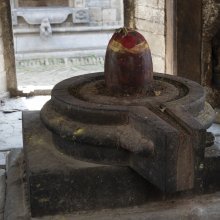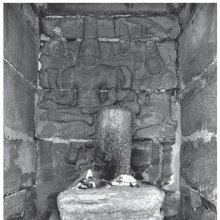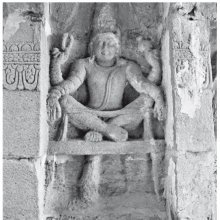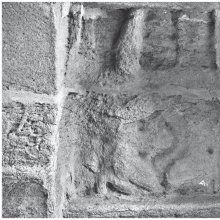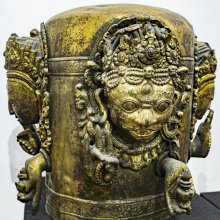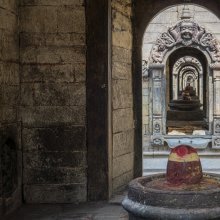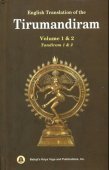Linga, Liṅgā, Liṅga, Limga: 45 definitions
Introduction:
Linga means something in Buddhism, Pali, Hinduism, Sanskrit, Jainism, Prakrit, the history of ancient India, Marathi, biology. If you want to know the exact meaning, history, etymology or English translation of this term then check out the descriptions on this page. Add your comment or reference to a book if you want to contribute to this summary article.
Images (photo gallery)
(+53 more images available)
In Hinduism
Shaivism (Shaiva philosophy)
Source: Wisdom Library: Ṣaṭsāhasra-saṃhitāLiṅgā (लिङ्गा):—One of the twelve guṇas associated with Gola, the sixth seat of the Svādhiṣṭhāna-chakra. According to tantric sources such as the Śrīmatottara-tantra and the Gorakṣasaṃhitā (Kādiprakaraṇa), these twelve guṇas are represented as female deities. According to the Ṣaṭsāhasrasaṃhitā however, they are explained as particular syllables. They (e.g. Liṅgā) only seem to play an minor role with regard to the interpretation of the Devīcakra (first of five chakras, as taught in the Kubjikāmata-tantra).
Source: Archaeological Survey of India: Śaiva monuments at Paṭṭadakal (śaivism)Liṅga (लिङ्ग).—The worship of Liṅga on the earth is the fruit of a quarrel between Brahmā and Viṣṇu. Episodes on how and why there was a quarrel between the two great gods and how that is the root cause for Liṅga to descend for worship by living beings on the earth, are narrated mainly in the Liṅgapurāṇa and Śivapurāṇa.
Source: McGill: The architectural theory of the Mānasāra (shaivism)Liṅga (लिङ्ग).—The liṅga is understood as the “semi-iconic image of Śiva”, because of its form and nature as falling somewhat between the iconic and the aniconic. Liṅga literally means “phallus”, and has undeniable phallic connotations even in its abstract iconographic form as a cylindrical shaft; as noted above, sometimes the five faces of Sadāśiva are also carved on the shaft.
Source: Shodhganga: The saurapurana - a critical study (shaivism)Liṅga (लिङ्ग) refers to the “symbol of Śiva”.—One remarkable contribution made by the Śaivas to the conception and worship of the Supreme Deity is the representation of Śiva in the form of a Symbol called liṅga, The very idea of liṅga implies that it is the seed or source of all derivative existences. It is that in which all diversities remain dissolved or undifferentiated or potentially present and from which they are originated. All existences are unified in liṅga which is the ultimate ground and final end of phenomenal beings.
Source: Brill: Śaivism and the Tantric TraditionsLiṅga (लिङ्ग) refers to “sectarian marks”, according to the Mālinīvijayottaratantra, chapter 18 (“appropriate conduct of the accomplished Yogin”) verses 18.74-81 (as quoted in the Tantrāloka verse 4.213-221ab).—Accordingly, “[...] And as regards the performance or non-performance of vows, etc., and entrance into sacred places, etc. [i.e., kṣetras, pīṭhas, and upapīṭhas], the observance of rules of action, and (those rules associated with) initiatory name, initiatory lineage, or the like [i.e., according to the lodge and the like of the initiate], whether the form, sectarian marks, and so on be one’s own or another’s [i.e., liṅga—parasvarūpaliṅgādi]—nothing is prescribed here regarding these, nor, contrariwise, prohibited. [...]”.

Shaiva (शैव, śaiva) or Shaivism (śaivism) represents a tradition of Hinduism worshiping Shiva as the supreme being. Closely related to Shaktism, Shaiva literature includes a range of scriptures, including Tantras, while the root of this tradition may be traced back to the ancient Vedas.
Shilpashastra (iconography)
Source: Google Books: Elements of Hindu iconographyLiṅga (लिङ्ग).—Śiva is worshipped in a number of anthropomorphic forms, as also in the symbol of Liṅga. Liṅgas are broadly divided into two classes, namely:
- calaliṅga (the movable liṅgas),
- acalaliṅga (the immovable liṅgas).
To the latter belong class belong the large and heavy stone Liṅgas which are permanently set up in the central shrines of Śiva temples.
Liṅgas are almost always set up in pedestals known as the piṇḍikā or pīṭha. These may be square, oblongular, octogonal, elongated octagon, hexagon, elongated hexagon, duodecagon, elongated duodecagon, 16-sided, regular or elongated, circular, elliptical, triangular and semi-circular in plan.
Source: Red Zambala: Hindu Icons and Symbols | TrinityŚiva, is primarily worshiped through the abstract symbol of the Liṅga—the phallus which is depicted standing in a base which encircles and holds it—the yoni or the womb. The Liṅga ejaculates the seed (bīja) of the spatial universe into the yoni which is the matrix of all manifestation.
Source: Archaeological Survey of India: Śaiva monuments at Paṭṭadakal (śilpa)Liṅga (लिङ्ग).—According to Ajitamahātantra (thirty-sixth paṭala) “Śiva should be represented standing in the middle of the liṅga, with three eyes, four arms, red color, a serene face, adorned with all ornaments, wearing the mesh-headgear (jaṭāmukuṭa), having Moon and Gaṅgā (in his hair) on his right and left respectively, wearing serpents, and datura flowers on his right and left, so that in the middle of the Liṅga he is visible without feet at the bottom and the top of the head being visible. Or one third of that should be visible. At the top and base of the Liṅga one should make Brahman in the form of a haṃsa and Viṣṇu with the head of a boar. Brahman and Viṣṇu should be made standing, their hands should be joined into a cup(añjalihasta), on the right and left of the Liṅga” (śloka 207-211).
It is stated in the Kāraṇāgama that one-fifth part of the liṅga should be left on the top and at the bottom respectively without any sculpture.... The colour of the figure of Śiva should be red, that of Viṣṇu black and that of Brahman golden yellow.
Source: McGill: The architectural theory of the Mānasāra (iconography)Liṅga (लिङ्ग).—In Mānasāra chapter LII, liṅgavidhānam, “Composition of Liṅga”, the options of deriving height of liṅga, the semi-iconic image of Śiva (usually the principal pratiṣṭhā, “consecrated image”, in a Saiva temple) number seven. They are:
- from the breadth of the adytum of the temple;
- from the door;
- from the width of the temple;
- from the height of the base of the temple;
- from the height of the main pillar;
- according to hasta, cubit;
- from the body of the yajamāna, patron or “c1ient”.
These lists of options display an “instrumental” nature, primarily as a means of procuring the height of the image.
Source: Shodhganga: The significance of the mūla-beras (śilpa)Liṅga (symbol of Śiva) refers to one of the several “attributes” (āyudha) or “accessories” of a detiy commonly seen depicted in Hindu iconography, defined according to texts dealing with śilpa (arts and crafs), known as śilpaśāstras.—The śilpa texts have classified the various accessories under the broad heading of āyudha or karuvi (implement), including even flowers, animals, and musical instruments. The other miscellaneous articles found as attributes in the hands of the deities are, for example, Liṅga.
Source: Shodhganga: The saurapurana - a critical study (shilpa)Liṅga (लिङ्ग) (in shape) is like the part of a short round coloumn rounded at the top and fixed in a raised round base of a paticular shape, that is open on the northern side. Since God is beyond name and form and since we can’t conceive of an abstract principle like Him, without the aid of concrete symbols, a rounder surface is perhaps the nearest approach to him. The Purāṇas indicate the custom of establishing such liṅgas at holy places; and in that case the liṅga bears the name of the person who has established it, with the word īśa or īśvara attached at the end e.g. Śukreśvara established by Śukra, Brahmeśvara by Brahmā, Vyāseśvara by Vyāsa, Dakṣeśvara by Dakṣa etc.

Shilpashastra (शिल्पशास्त्र, śilpaśāstra) represents the ancient Indian science (shastra) of creative arts (shilpa) such as sculpture, iconography and painting. Closely related to Vastushastra (architecture), they often share the same literature.
Vaishnavism (Vaishava dharma)
Source: ISKCON Press: Glossary1) Liṅga (लिङ्ग).—Phallic symbol which is used in the worship of Lord Śiva.
2) Liṅga (लिङ्ग).—The subtle body: mind, intelligence and false ego.

Vaishnava (वैष्णव, vaiṣṇava) or vaishnavism (vaiṣṇavism) represents a tradition of Hinduism worshipping Vishnu as the supreme Lord. Similar to the Shaktism and Shaivism traditions, Vaishnavism also developed as an individual movement, famous for its exposition of the dashavatara (‘ten avatars of Vishnu’).
Purana and Itihasa (epic history)
Source: Cologne Digital Sanskrit Dictionaries: The Purana Index1a) Liṅga (लिङ्ग).—A term for mahat.*
- * Vāyu-purāṇa 102. 21.
1b) A term for Jīva.*
- * Vāyu-purāṇa 102. 101.
1c) Origin of; came out of a ball of ever-burning fire and grew and grew; Viṣṇu and Brahmā undertook to find out its beginning and the end. It was all effulgence. They found it impossible and prayed to Śiva who initiated them into māheśvaram bala.1 Establishment of the cult in the presence of Śiva and the sages; is Jīva, mahat; leads to kaivalya;2 found in Godāvarī;3 worship of at Benares relieves one of rebirth;4 its size for installation in the palace depends on the measurement of the palace; nine varieties are distinguished. The technique of the making of a Linga is furnished in detail. It may be of gems, spaṭika, of stone, earth, or wood.5
- 1) Brahmāṇḍa-purāṇa II. 26. 21 to the end; 27. 30-101; Vāyu-purāṇa 55. 21-61.
- 2) Brahmāṇḍa-purāṇa IV. 3. 22, 56-9, 79.
- 3) Matsya-purāṇa 22. 57.
- 4) Ib. 154. 350; 185. 57.
- 5) Ib. 263. 1, 11, 25.
Liṅga (लिङ्ग) refers to the most sacred object of worship in Śaivism, according to the 10th century Saurapurāṇa: one of the various Upapurāṇas depicting Śaivism.—The Saurapurāṇa mentions the different types of liṅgas as Svayambhū-liṅga which showed it-self in a natural way, the Pratiṣṭhita-liṅga which is established or installed with proper mantras; Rasa-liṅga, Bāṇa-liṅga, Svarṇa-liṅga, Śilā-liṅga etc. Certain liṅgas are called Jyotirliṅgas and they are said to be twelve in number such as Viśveśvara, Ratneśvara at Vārāṇasī, Mahākāla at Ujjayinī etc. The liṅgas described in the Saurapurāṇa are discussed in chapter VI of this work under tīrthas.

The Purana (पुराण, purāṇas) refers to Sanskrit literature preserving ancient India’s vast cultural history, including historical legends, religious ceremonies, various arts and sciences. The eighteen mahapuranas total over 400,000 shlokas (metrical couplets) and date to at least several centuries BCE.
Samkhya (school of philosophy)
Source: Shodhganga: Prakrti and purusa in Samkhyakarika an analytical reviewLiṅga (लिङ्ग, “mark of anything”).—The existence of avyakta can be inferred on the basis of vyakta. For this reason, vyakta is called liṅga (mark) of the inference of avyakta. So, the term liṅga is used here in the sense of anumāpaka or hetu (mark). Though to infer puruṣa, prakṛti (pradhāna) is used as a liṅga, still prakṛti is not a liṅga for the inference of itself. That is what is indicated by Vācaspati in saying “liṅgam pradhānasya”. Here, the term liṅga has been used to denote the anumāpaka of pradhāna. How the vyaktas are used as liṅga for the inference of pradhāna is narrated in Sāṃkhyakārikā 15.

Samkhya (सांख्य, Sāṃkhya) is a dualistic school of Hindu philosophy (astika) and is closeley related to the Yoga school. Samkhya philosophy accepts three pramanas (‘proofs’) only as valid means of gaining knowledge. Another important concept is their theory of evolution, revolving around prakriti (matter) and purusha (consciousness).
Vyakarana (Sanskrit grammar)
Source: Shodhganga: Vaiyākaraṇabhūṣaṇasāra: a critical studyLiṅga (लिङ्ग).—Gender which is accepted by the Grammarians as one of the five meanings of a nominal stem.
Source: Wikisource: A dictionary of Sanskrit grammar1) Liṅga (लिङ्ग).—Sign or characteristic mark; generally the mute letter prefixed or suffixed to roots, affixes, or augments and their substitutes with a specific purpose; cf. किंचिल्लिङ्गमासज्य वक्ष्यामि (kiṃcilliṅgamāsajya vakṣyāmi) M. Bh.on I.1.1 Vārt.7, अवयवे कृतं लिङ्ग समुदायस्य विशेषकं भवति (avayave kṛtaṃ liṅga samudāyasya viśeṣakaṃ bhavati) M. Bh. on P.I.3.62 Vārt. 5;
2) Liṅga.—Proof, evidence (प्रमाण (pramāṇa)); the word is often used in the Paribhāșendușekhara and other works in connection with a rule or part of a rule quoted as an evidence to deduce some general dictum or Paribhāșā;
3) Liṅga.—Gender; cf. लिङ्ग स्त्रीलिङ्गपुंलिङ्गनपुंसकानि (liṅga strīliṅgapuṃliṅganapuṃsakāni) Kāś. on P. II. 3. 46; cf. also प्रातिपदिकग्रहणे लिङ्गविशिष्टस्यापि ग्रहणम् (prātipadikagrahaṇe liṅgaviśiṣṭasyāpi grahaṇam). Par. Śek.Pari.71. The gender of a word in Sanskrit language does not depend on any specific properties of a thing; it simply depends on the current usage; cf. लोकाश्रयत्वाल्लिङ्गस्य (lokāśrayatvālliṅgasya) which is often quoted in the Mahābhāsya; cf. M. Bh. on P. II. 1.36, II.2.29, II.4.12, IV. 1.3, V.3.66, V.4.68, VIII.1.15. For details see Mahābhāșya on P.IV.1. 3 where after a long enlightening discussion the definition संस्त्यानप्रसवौ लिङ्गम् (saṃstyānaprasavau liṅgam) is given.

Vyakarana (व्याकरण, vyākaraṇa) refers to Sanskrit grammar and represents one of the six additional sciences (vedanga) to be studied along with the Vedas. Vyakarana concerns itself with the rules of Sanskrit grammar and linguistic analysis in order to establish the correct context of words and sentences.
Nirukta (Sanskrit etymology)
Source: Shodhganga: The saurapurana - a critical study (nirukta)Liṅga (लिङ्ग) is said to have the idea of merging.—According to Nirukta (4.19) the word liṅga means “lustful”.—As everything gets merged in it it is called liṅga. It is pointed out that the fusion of the symbols of Śiva and Śakti, namely the penis and the vagina, is called liṅga. Another etymology of the word is that the liṅga is so called because it makes the lina or avvakta that is Śiva, known.
In a passage of the Saurapurāṇa, Nārada asks Brahmā as to what is called liṅga; then Brahma gives the definition of liṅga:
“That form of Mahādeva which is Unmanifest (avvakta) is called liṅga; it is bliss (ānanda) and beyond all nescience (tamasaḥ paraṃ). By the liṅga Śaṃkara is Liṅgī”.
Nirukta (निरुक्त) or “etymology” refers to the linguistic analysis of the Sanskrit language. This branch studies the interpretation of common and ancient words and explains them in their proper context. Nirukta is one of the six additional sciences (vedanga) to be studied along with the Vedas.
Ayurveda (science of life)
Source: gurumukhi.ru: Ayurveda glossary of terms1) Liṅga (लिङ्ग):—A distinguishing mark or a feature, attribute, or trait; that’s points towards a co-relation
2) Penis

Āyurveda (आयुर्वेद, ayurveda) is a branch of Indian science dealing with medicine, herbalism, taxology, anatomy, surgery, alchemy and related topics. Traditional practice of Āyurveda in ancient India dates back to at least the first millenium BC. Literature is commonly written in Sanskrit using various poetic metres.
Yoga (school of philosophy)
Source: Google Books: Croaking Frogs: (Yoga)Liṅga (लिङ्ग) refers to the “penis” representing one of the sixteen vital centres of the body (i.e., ādhāra), according to the Jyotsnā 3.73 (Cf. Gorakṣaśataka 14 and Svātmārāma’s Haṭhapradīpikā 3.72).—In Haṭhayoga, ādhāra refers to a vital point of the body, a seat of vital function. Jyotsnā verse 3.73 cites a passage attributed to Gorakṣa listing the ādhāras as [e.g., liṅga (penis), ...]. The Haṭhapradīpikā refers to sixteen ādhāras but does not name them or explain what they are. The Gorakṣaśataka also refers to sixteen ādhāras as something the Yogī should be familiar with, but does not name them.

Yoga is originally considered a branch of Hindu philosophy (astika), but both ancient and modern Yoga combine the physical, mental and spiritual. Yoga teaches various physical techniques also known as āsanas (postures), used for various purposes (eg., meditation, contemplation, relaxation).
Kama-shastra (the science of Love-making)
Source: Brill: Śaivism and the Tantric Traditions (kāmasūtra)Liṅga (लिङ्ग) (Cf. Liṅgatva) refers to the “penis”, according to the Kāmasūtra of Vātsyāyana and Jaśodhara’s commentary called the Jayamaṅgalā .—Accordingly, “[Commentary on verse 7.2.2]:—‘about to practice sex’: at the beginning of the sexual act. This is at the start [of the sexual act]. Even if the passion is weak with regards to sex because the penis is inert (stabdha-liṅgatva), first ‘her genitalia’, i.e. her vulva, should be rubbed with his hand, should be stimulated with the ‘elephant trunk’ [method]...”.
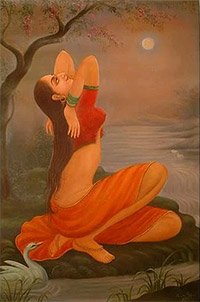
Kamashastra (कामशास्त्र, kāmaśāstra) deals with ancient Indian science of love-making, passion, emotions and other related topics dealing with the pleasures of the senses.
Pancaratra (worship of Nārāyaṇa)
Source: University of Vienna: Sudarśana's Worship at the Royal Court According to the AhirbudhnyasaṃhitāLiṅga (लिङ्ग) refers to “signs” (i.e., ‘omens that indicate the performance of an aggressive ritual by the enemy’), according to the Ahirbudhnyasaṃhitā, belonging to the Pāñcarātra tradition which deals with theology, rituals, iconography, narrative mythology and others.—Accordingly, “An abnormal modification caused by a aggressive ritual against Kings, occurring at the improper time, dreadful and all-reaching, is characterized by the these signs: [...] [the King] is so deluded that he himself forgets the dos and don’ts; in a dream he sees himself with a shaven head and clad in a dark blue garment, travelling towards the southern direction on a cart pulled by a donkey; from such and other signs (liṅga—ityādiliṅgair) he should understand that the enemy is performing a aggressive ritual”.

Pancaratra (पाञ्चरात्र, pāñcarātra) represents a tradition of Hinduism where Narayana is revered and worshipped. Closeley related to Vaishnavism, the Pancaratra literature includes various Agamas and tantras incorporating many Vaishnava philosophies.
Vastushastra (architecture)
Source: Shodhganga: Elements of Art and Architecture in the Trtiyakhanda of the Visnudharmottarapurana (vastu)Liṅga (लिङ्ग) refers to one of the hundred types of Temples (in ancient Indian architecture), according to the Viṣṇudharmottarapurāṇa, an ancient Sanskrit text which (being encyclopedic in nature) deals with a variety of cultural topics such as arts, architecture, music, grammar and astronomy.—It is quite difficult to say about a definite number of varieties of Hindu temples but in the Viṣṇudharmottarapurāṇa hundred varieties of temples have been enumerated. For example, Liṅga. These temples are classified according to the particular shape, amount of storeys and other common elements, such as the number of pavilions, doors and roofs. [...] The Viṣṇudharmottarapurāṇa relates that the temple named Liṅga should be constructed in liṅga shape.

Vastushastra (वास्तुशास्त्र, vāstuśāstra) refers to the ancient Indian science (shastra) of architecture (vastu), dealing with topics such architecture, sculpture, town-building, fort building and various other constructions. Vastu also deals with the philosophy of the architectural relation with the cosmic universe.
In Buddhism
Tibetan Buddhism (Vajrayana or tantric Buddhism)
Source: OSU Press: Cakrasamvara SamadhiLiṅga (लिङ्ग) refers to the “upper genitals” (i.e., penis or clitoris) and is associated with the syllable preṃ, according to the Cakrasaṃvara Samādhi [i.e., Cakrasamvara Meditation] ritual often performed in combination with the Cakrasaṃvara Samādhi, which refers to the primary pūjā and sādhanā practice of Newah Mahāyāna-Vajrayāna Buddhists in Nepal.—Accordingly, “[Do caturviṃśati-aṅga nyāsa; Touch twenty-one parts of one’s body with right middle finger, and recite seed syllables] ... Preṃ on the upper genitals (preṃ liṅge)”.

Tibetan Buddhism includes schools such as Nyingma, Kadampa, Kagyu and Gelug. Their primary canon of literature is divided in two broad categories: The Kangyur, which consists of Buddha’s words, and the Tengyur, which includes commentaries from various sources. Esotericism and tantra techniques (vajrayāna) are collected indepently.
In Jainism
General definition (in Jainism)
Source: Encyclopedia of Jainism: Tattvartha Sutra 9: Influx of karmasLiṅga (लिङ्ग, “sign”).—One of the seven sub categories of ascetics (nirgrantha-muni);—What are the peculiarities amongst different kind of ascetics with reference to ‘the sign’ (liṅga)?
With reference to the psychic signs, all the five types of ascetics (pulāka, bakuśa, kuśīla, nirgrantha, snātaka) are bhāva-liṅga (have psychic signs as they are all with right faith and practice self-control).
With reference to physical signs, all ascetics barring successful ascetics have the whisk and the water pot even though all of them are sky clad unbound ascetics.
Source: Encyclopedia of Jainism: Tattvartha Sutra 2: the Category of the livingLiṅga (लिङ्ग, “gender”) refers to a category of dispositions (bhāva) due to the rising of karmas (audayika), according to the 2nd-century Tattvārthasūtra 2.6. What is the meaning of sexes (liṅga)? State caused due to the rise of quasi passion known as veda or sex. How many types of sexes are there? There are three types of sexes namely male, female and neutral. What causes different types of sexes? Rise of different types (male, female and neutral) of sex (veda) tendencies of physique making karmas results in the respective sexes.
Source: The University of Sydney: A study of the Twelve ReflectionsLiṅga (लिङ्ग) refers to the “characteristic” (of the doctrine), according to the 11th century Jñānārṇava, a treatise on Jain Yoga in roughly 2200 Sanskrit verses composed by Śubhacandra.—Accordingly, “Anything which is undesirable for oneself is not to be done to others by the actions of [body,] speech and mind, even in a dream—such is the principal characteristic of the doctrine (agrima—dharmasyāgrimaṃ liṅgam)”.
Synonyms: Lakṣaṇa.

Jainism is an Indian religion of Dharma whose doctrine revolves around harmlessness (ahimsa) towards every living being. The two major branches (Digambara and Svetambara) of Jainism stimulate self-control (or, shramana, ‘self-reliance’) and spiritual development through a path of peace for the soul to progess to the ultimate goal.
India history and geography
Source: Cologne Digital Sanskrit Dictionaries: Indian Epigraphical GlossaryLiṅga.—(BL; SII 1; CII 3, etc.), same as śiva-liṅga; the phallic emlem of Śiva; the emblem connected with the worship of Śiva; generally named after the founder with the suffix īśvara. Note: liṅga is defined in the “Indian epigraphical glossary” as it can be found on ancient inscriptions commonly written in Sanskrit, Prakrit or Dravidian languages.
Source: Shodhganga: The saurapurana - a critical study (history)Liṅga (लिङ्ग) refers to the “most sacred object of worship in Shaivism”.—In present day India in the Shaiva-temples and sanctuaries, the most sacred object of worship is the Shiva-linga. The Linga-Cult is traced to the Rigveda where the Vedic Aryans swear at the barbarians describing them as shishnadevas (people to whom the Phallus is a god). According to Nirukta (4.19) the word Linga means “lustful”. Thus the exactimport of the word is far from certain. Nor it is certain whether there were actual phallus-worshipper among the pre-vedic population; but it seems a probable assumption; for in Mahenjodaro and Harappa plenty of clay and stone representions of the male organ are found.

The history of India traces the identification of countries, villages, towns and other regions of India, as well as mythology, zoology, royal dynasties, rulers, tribes, local festivities and traditions and regional languages. Ancient India enjoyed religious freedom and encourages the path of Dharma, a concept common to Buddhism, Hinduism, and Jainism.
Biology (plants and animals)
Source: Google Books: CRC World Dictionary (Regional names)Linga in Vernacular names is the name of a plant defined with Montrichardia linifera in various botanical sources. This page contains potential references in Ayurveda, modern medicine, and other folk traditions or local practices It has the synonym Caladium liniferum (Arruda) Nees (among others).
Example references for further research on medicinal uses or toxicity (see latin names for full list):
· Transactions of the Linnean Society of London (1839)
· Systema Vegetabilium (1827)
If you are looking for specific details regarding Linga, for example diet and recipes, pregnancy safety, health benefits, extract dosage, side effects, chemical composition, have a look at these references.

This sections includes definitions from the five kingdoms of living things: Animals, Plants, Fungi, Protists and Monera. It will include both the official binomial nomenclature (scientific names usually in Latin) as well as regional spellings and variants.
Languages of India and abroad
Pali-English dictionary
Source: BuddhaSasana: Concise Pali-English Dictionaryliṅga : (nt.) sign; mark; attribute; feature; the generative organ; the gender (in grammar).
Source: Sutta: The Pali Text Society's Pali-English DictionaryLiṅga, (nt.) (fr. liṅg; late Vedic & (pre-eminently) Class. Sk. linga) 1. characteristic, sign, attribute, mark, feature M. I, 360; S. V, 278; Sn. 601 sq. (=saṇṭhāna SnA 464); Vin. IV, 7 (two: hīna & ukkaṭṭha); J. I, 18; IV, 114 (gihi°), 130; Miln. 133 (sāsana°), 162 (dve samaṇassa lingāni), 405 (lingato ca nimittato ca etc.); Vism. 184; DhsA. 64 (=saṇṭhāna Tīkā: Expos. 86).—2. mark of sex, sexual characteristic, pudendum (male as well as female, as neither m. nor f.) Vin. III, 35 (purisa°); J. V, 197 (°saṇṭhāna); KhA 110 (itthi°); SnA 48 (°sampatti), 51 (id.), 300 (itthi°); DhsA. 321 sq. (itthi°).—3. (in grammar) mark of sex, (characteristic) ending, gender SnA 397. °vipallāsa change or substitution of gender PvA. 7, 33, 58, 87, 157. (Page 584)

Pali is the language of the Tipiṭaka, which is the sacred canon of Theravāda Buddhism and contains much of the Buddha’s speech. Closeley related to Sanskrit, both languages are used interchangeably between religions.
Marathi-English dictionary
Source: DDSA: The Molesworth Marathi and English Dictionaryliṅga (लिंग).—n (S) The penis. 2 Gender. (pulliṅga Masculine, strīliṅga Feminine, napuṃsakaliṅga Neuter.) 3 The Phallus or emblematic representation of Shiva. 4 An affix to the names of worshipers of the lingam; as dādaliṅga, sadaliṅga. 5 A distinguishing mark; a sign, token, badge. 6 Nature or Prakriti, according to the Sankhya philosophy; the active or motive power in creation. 7 (fig. of 1st Sig.) A clog or an encumbrance: anything that ties down or confines: also a trouble or difficulty freely. v lāga, aḍaka, asa. liṅgavibhakti sambhāḷūna bōlaṇēṃ To speak grammatically.
Source: DDSA: The Aryabhusan school dictionary, Marathi-Englishliṅga (लिंग).—n Gender. The emblematic representation. A distinguishing mark, a sign, token of śiva.
Marathi is an Indo-European language having over 70 million native speakers people in (predominantly) Maharashtra India. Marathi, like many other Indo-Aryan languages, evolved from early forms of Prakrit, which itself is a subset of Sanskrit, one of the most ancient languages of the world.
Sanskrit dictionary
Source: DDSA: The practical Sanskrit-English dictionaryLiṅga (लिङ्ग).—[liṅg-ac]
1) A mark, sign, token, an emblem, a badge, symbol, distinguishing mark, characteristic; यतिपार्थिवलिङ्गधारिणौ (yatipārthivaliṅgadhāriṇau) R.8.16; अथवा प्रावृषेण्यैरेव लिङ्गै- र्मम राजोपचारः संप्रति (athavā prāvṛṣeṇyaireva liṅgai- rmama rājopacāraḥ saṃprati) V.4; मुनिर्दोहदलिङ्गदर्शी (munirdohadaliṅgadarśī) 14.71; Manusmṛti 1. 3;8.25,252.
2) A false or unreal mark, a guise, disguise, a deceptive badge; लिङ्गैर्मुदः संवृतविक्रियास्ते (liṅgairmudaḥ saṃvṛtavikriyāste) R.7. 3; क्षपणकलिङ्गधारी (kṣapaṇakaliṅgadhārī) Mu.1; न लिङ्गं धर्मकारणम् (na liṅgaṃ dharmakāraṇam) H.4.85. See लिङ्गिन् (liṅgin) below.
3) A symptom, mark of disease.
4) A means of proof, a proof, evidence.
5) (In logic) The hetu or middle term in a syllogism; particularly the assertion of the hetu's being found in the पक्ष (pakṣa) or minor term coupled with the statement of the invariable concomitance between this hetu and the major term; it is thus defined:-व्याप्तिपक्षधर्मतावल्लिङ्गम् (vyāptipakṣadharmatāvalliṅgam) Tarka K.
6) The sign of gender or sex.
7) Sex; गुणाः पूजास्थानं गुणिषु न च लिङ्गं न च वयः (guṇāḥ pūjāsthānaṃ guṇiṣu na ca liṅgaṃ na ca vayaḥ) Uttararāmacarita 4.11.
8) The male organ of generation.
9) Gender (in gram.)
1) The genital organ of Śiva worshipped in the form of a Phallus.
11) The image of a god, an idol; धत्तेऽसावात्मनो लिङ्गं मायया विसृजन् गुणान् (dhatte'sāvātmano liṅgaṃ māyayā visṛjan guṇān) Bhāgavata 7.2.22.
12) One of the relations or indications (such as saṃyoga, viyoga, sāhacarya &c.) which serve to fix the meaning of a word in any particular passage; e. g. in कुपितो मकरध्वजः (kupito makaradhvajaḥ) the word कुपित (kupita) restricts the meaning of मकरध्वज (makaradhvaja) to 'Kāma'; see K. P.2 and commentary ad loc.; तदेव सक्तः सह कर्मणैति लिङ्गं मनो यत्र निषक्तमस्य (tadeva saktaḥ saha karmaṇaiti liṅgaṃ mano yatra niṣaktamasya) Bṛ. Up.4.4.6.
13) (In Vedānta phil.). The subtle frame or body, the indestructible original of the gross or visible body; cf. पञ्चकोष (pañcakoṣa); यं योगिनो योग- समाधिना रहो ध्यायन्ति लिङ्गादसुतो ममुक्षया (yaṃ yogino yoga- samādhinā raho dhyāyanti liṅgādasuto mamukṣayā) Bhāgavata 3.19.28.
14) A spot, stain.
15) The nominal base, the crude form of a noun (prātipadika).
16) (In Sāṅ. phil.) Pradhāna or Prakṛti; q. v.
17) The effect or product (that which is evolved out of a primary cause and itself becomes a producer).
18) Inference, conclusion; अव्यक्तमिति विज्ञेयं लिङ्गग्राह्यमतीन्द्रियम् (avyaktamiti vijñeyaṃ liṅgagrāhyamatīndriyam) Mahābhārata (Bombay) 12.189.15.
19) = उपाधि (upādhi); योगेन धृत्युद्यमसत्त्वयुक्तो लिङ्गं व्यपोहेत् कुशलोऽहमाख्यम् (yogena dhṛtyudyamasattvayukto liṅgaṃ vyapohet kuśalo'hamākhyam) Bhāgavata 5.5.13.
Derivable forms: liṅgam (लिङ्गम्).
Source: Cologne Digital Sanskrit Dictionaries: Shabda-Sagara Sanskrit-English DictionaryLiṅga (लिङ्ग).—n.
(-ṅkaṃ) 1. A mark, a spot, a stain, a sign, a token, &c. 2. A badge or mark assumed with a view to deceive. 3. A sign of sex, the penis. 4. The phallus, or Siva under that emblem. 5. Inference, probable conclusion. 6. The premises leading to a conclusion. 7. Nature or Prakriti, according to the Sank'hya philosophy, which considers this as the active power in cretion. 8. Gender, (as puṃliṅgaḥ the masculine gender, &c.) 9. The order of the religious student. 10. Symptom or mark of disease. 11. The predicate of a proposition. 12. Evidence. E. ligi to go, &c., aff. ac .
Source: Cologne Digital Sanskrit Dictionaries: Benfey Sanskrit-English DictionaryLiṅga (लिङ्ग).—n. 1. A mark, a sign, [Nala] 5, 14. 2. A spot. 3. A religious mark, [Mānavadharmaśāstra] 4, 200. 4. The penis. 5. The phallus, or Śiva under that emblem. 6. Nature, as the active power in creation. 7. The primary body, [Vedāntasāra, (in my Chrestomathy.)] in
Liṅga (लिङ्ग).—[neuter] mark, sign, emblem, badge, characteristic, attribute, sectarian mark; proof, means of proof, evidence ([jurisprudence]); organ of generation, [especially] the male organ of Śiva ([ritual or religion]); idol i.[grammar]; gender ([grammar]), the subtile frame or body (ph.).
Source: Cologne Digital Sanskrit Dictionaries: Monier-Williams Sanskrit-English Dictionary1) Liṅga (लिङ्ग):—[from liṅg] n. (once m. in [Nṛsiṃha-tāpanīya-upaniṣad]; ifc. f(ā). , f(ī). only in viṣṇu-liṅgī; [probably] [from] √lag; cf. lakṣa, lakṣaṇa) a mark, spot, sign, token, badge, emblem, characteristic (ifc. = tal-liṅga, ‘having anything for a mark or sign’), [Upaniṣad; Mahābhārata] etc.
2) [v.s. ...] any assumed or false badge or mark, guise, disguise, [Mahābhārata; Kāvya literature] etc.
3) [v.s. ...] a proof, evidence, [Kaṇāda’s Vaiśeṣika-sūtra; Kātyāyana-śrauta-sūtra; Sarvadarśana-saṃgraha]
4) [v.s. ...] a sign of guilt, corpus delicti, [Yājñavalkya [Scholiast or Commentator]]
5) [v.s. ...] the sign of gender or sex, organ of generation, [Manu-smṛti; Harivaṃśa; Purāṇa] etc.
6) [v.s. ...] the male organ or Phallus ([especially] that of Śiva worshipped in the form of a stone or marble column which generally rises out of a yoni, q.v., and is set up in temples dedicated to Śiva; formerly 12 principal Śiva-liṅgas existed, of which the best known are Soma-nātha in Gujarāt, Mahā-kāla at Ujjayinī, Viśveśvara at Benares etc.; but the number of Liṅgas in India is estimated at 30 millions, [Indian Wisdom, by Sir M. Monier-Williams 322 n.; Religious Thought and Life in India 78, 1; 90]), [Mahābhārata; Rāmāyaṇa] etc.
7) [v.s. ...] gender (in gram.; cf. puṃ-l), Prst, [Pāṇini]
8) [v.s. ...] the image of a god, an idol, [Varāha-mihira’s Bṛhat-saṃhitā]
9) [v.s. ...] (in logic) = vyāpya, the invariable mark which proves the existence of anything in an object (as in the proposition ‘there is fire because there is smoke’, smoke is the liṅga; cf. [Indian Wisdom, by Sir M. Monier-Williams 62])
10) [v.s. ...] inference, conclusion, reason (cf. kāvya-l)
11) [v.s. ...] = liṅgaśarīra (in Vedānta)
12) [v.s. ...] anything having an origin and therefore liable to be destroyed again, [Kapila]
13) [v.s. ...] = ākāśa, [Kāraṇḍa-vyūha]
14) [v.s. ...] (in Sāṃkhya) = prakṛti or pradhāna, ‘the eternal procreative germ’ [cf. Lexicographers, esp. such as amarasiṃha, halāyudha, hemacandra, etc.]
15) [v.s. ...] = vyakta, [cf. Lexicographers, esp. such as amarasiṃha, halāyudha, hemacandra, etc.]
16) [v.s. ...] cf. [Religious Thought and Life in India 30]
17) [v.s. ...] = prātipadika, the crude base or uninflected stem of a noun (shortened into li), [Vopadeva [Scholiast or Commentator]]
18) [v.s. ...] (in [rhetoric]) an indication (word that serves to fix the meaning of another word; e.g. in the passage kupito makara-dhvajaḥ the word kupita restricts the meaning of makara-dhvaja to ‘Kāma’) = liṅga-purāṇa, [Bhāgavata-purāṇa]
19) [v.s. ...] the order of the religious student, [Horace H. Wilson]
20) [v.s. ...] a symptom, mark of disease, [Horace H. Wilson]
Source: Cologne Digital Sanskrit Dictionaries: Yates Sanskrit-English DictionaryLiṅga (लिङ्ग):—(ṅgaṃ) 1. n. A mark, a sign; the penis; the phallus; gender; inference or its premises; nature.
Source: DDSA: Paia-sadda-mahannavo; a comprehensive Prakrit Hindi dictionary (S)Liṅga (लिङ्ग) in the Sanskrit language is related to the Prakrit word: Liṃga.
[Sanskrit to German]
Sanskrit, also spelled संस्कृतम् (saṃskṛtam), is an ancient language of India commonly seen as the grandmother of the Indo-European language family (even English!). Closely allied with Prakrit and Pali, Sanskrit is more exhaustive in both grammar and terms and has the most extensive collection of literature in the world, greatly surpassing its sister-languages Greek and Latin.
Prakrit-English dictionary
Source: DDSA: Paia-sadda-mahannavo; a comprehensive Prakrit Hindi dictionary1) Liṃga (लिंग) in the Prakrit language is related to the Sanskrit word: Liṃṅag.
2) Liṃga (लिंग) also relates to the Sanskrit word: Liṅga.
Prakrit is an ancient language closely associated with both Pali and Sanskrit. Jain literature is often composed in this language or sub-dialects, such as the Agamas and their commentaries which are written in Ardhamagadhi and Maharashtri Prakrit. The earliest extant texts can be dated to as early as the 4th century BCE although core portions might be older.
Kannada-English dictionary
Source: Alar: Kannada-English corpusLiṃga (ಲಿಂಗ):—
1) [noun] a symbol, sign or a distinctive mark.
2) [noun] the male organ of copulation; the penis.
3) [noun] the fact or condition of being a male or a female human being, esp. with regard to how this affects or determines a person’s self-image, social status, goals, etc.
4) [noun] an image or representation of Śiva, in the form of a cylinder, with a outwardly curved top, fixed on to a base.
5) [noun] a miniature of this which is tied around the neck by Vīraśaivas.
6) [noun] anything serving or tending to establish the truth of something or to convince one of its truth; a proof.
7) [noun] (gram.) any of the three familiar sets of genders (as masculine, feminine, and neuter).
8) [noun] the original, un-inflected word.
9) [noun] ಲಿಂಗದಹೂವಿನಮರ [limgadahuvinamara] lingada hūvina mara the tree Courouptia guianensis of Lecythidaceae family.
Kannada is a Dravidian language (as opposed to the Indo-European language family) mainly spoken in the southwestern region of India.
See also (Relevant definitions)
Starts with (+194): Limgadaha, Limgadehi, Limgadharaka, Limgadharane, Limgadhari, Limgadikshe, Limgadura, Limgaikya, Limgamenasu, Limgamudre, Limganu, Limgapatha, Limgaroga, Limgarpita, Limgasaraya, Limgashariri, Limgasthala, Limgasvayata, Limgatanu, Limgatatva.
Ends with (+345): Abhedyalimga, Abhyantaralinga, Ablinga, Acalalinga, Acaralinga, Accalimga, Achalalinga, Acharalinga, Adharalimga, Adhyalinga, Adilimga, Agnilinga, Ajahallinga, Akashalinga, Alakshyalinga, Alinga, Amaralinga, Amgailimga, Amholinga, Amriteshvaralinga.
Full-text (+1876): Banalinga, Gauripatta, Lingarccana, Sthavaralinga, Jyotirlinga, Candesha, Trilinga, Mahalinga, Mrinmayalinga, Lingadeha, Shivalinga, Sarvasamalinga, Lingasharira, Ekalinga, Pratilingam, Pamcalimga, Pratishtha, Trairashikalinga, Bhulinga, Parthivalinga.
Relevant text
Search found 172 books and stories containing Linga, Liṅgā, Liṅga, Limga, Liṃga; (plurals include: Lingas, Liṅgās, Liṅgas, Limgas, Liṃgas). You can also click to the full overview containing English textual excerpts. Below are direct links for the most relevant articles:
Sahitya-kaumudi by Baladeva Vidyabhushana (by Gaurapada Dāsa)
Text 10.150 [Kāvya-liṅga] < [Chapter 10 - Ornaments of Meaning]
Text 10.152 < [Chapter 10 - Ornaments of Meaning]
Text 7.11 < [Chapter 7 - Literary Faults]
The Siva Linga: Conceptual, Iconographical and < [January – March, 1996]
West of My Village < [January 1937]
"Prabhu Devara Ragale" < [April 1940]
The Padma Purana (by N.A. Deshpande)
Chapter 34 - The Greatness of Kṛttivāseśvara < [Section 3 - Svarga-khaṇḍa (section on the heavens)]
Chapter 120 - The Greatness of Śālagrāma < [Section 6 - Uttara-Khaṇḍa (Concluding Section)]
Chapter 90 - The Powers of the Holy Places < [Section 2 - Bhūmi-khaṇḍa (section on the earth)]
Lakulisha-Pashupata (Philosophy and Practice) (by Geetika Kaw Kher)
Historicity (of the term linga) < [Chapter 6 - Siva-linga: an Iconological Study]
Kusika and the Ascetic Aspirants: Early form of Lakulisa-Pasupata order < [Chapter 2 - Spread and Transition]
Mukhalingas and esoteric meanings < [Chapter 6 - Siva-linga: an Iconological Study]
The Agni Purana (by N. Gangadharan)
Chapter 54 - The dimensions of different varieties of the Liṅga
Chapter 103 - Mode of repair of old or broken Liṅgas (jīrṇa-uddhāra)
Chapter 97 - Mode of installation of the image of (lord) Śiva (śivapratiṣṭhā)
The Linga Purana (by J. L. Shastri)
Chapter 74 - Description of Śiva Liṅgas < [Section 1 - Uttarabhāga]
Chapter 1 - Introductory < [Section 1 - Uttarabhāga]
Chapter 92 - Glory of Śrīśaila < [Section 1 - Uttarabhāga]
Related products
(+3 more products available)
